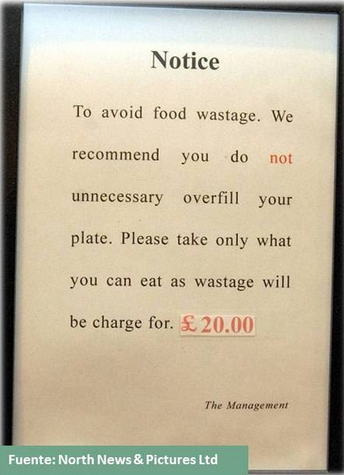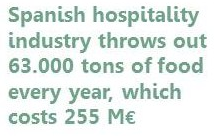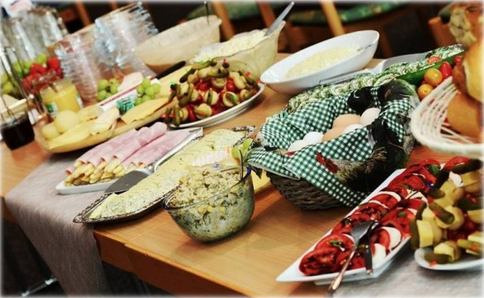
There is a restaurant in Japan where if its clients left one only rice grain in the plate, should pay a fine. Specialized in shellfish, the “Hachikyo Restaurant” offers a dish that consist of salmon roes over a white rice bed. The restaurant informs the customers who order this dish: “Working conditions of fisherman are hard and dangerous. To express our gratitude to the food that they provide, it is forbidden to leave one only rice grain in the plate. The costumers who don’t finish their tsukko meshi should give a donation.
These punitive measurements are been applied by some restaurants in different countries around the world to make people aware of the food waste in the hospitality sector, where in the case of Spain are thrown 63.000 tons of food per year, a wastage that costs 255 M€.
On average 21% of food waste arises from spoilage; 45% from food preparation and 34% from consumer plates (WRAP. 2013. “Overview of Waste in the UK Hospitality and Food Service Sector”).
If a restaurant wants to reduce their quantity of food waste, it have to identify what are the critical points where is throwing the food and them to apply solutions. Mismanagement purchasing, incorrect storage and conservation of products can become in waste of product, economic and resources (personal cost that prepare food that later rather will throw it, waste of energy during cooking, conservation, etc).
A point of improvement to reduce waste food can be the practices in food preparation at kitchen. Peel, chop, clean, cut are techniques that if it doesn’t do efficiently or it don`t use the correct utensils the quantity of product that is thrown can be very important.
The leftovers are the sign more obvious about the food waste. Portions too big or garnishes not consumed, should be an indication for take the initiative by the restaurant and provide some changes to the customers. These changes can be very attractive to clients concerned with the problem of food waste. Some tips to reduce waste:

• Offer in the menu different sizes of portions (whole, half portion, mini-portions, portions for kids, etc).
• Inform to the customers about the size of portion before they order their meal.
• Include in the menu some pictures of the dishes, in this way the customers can make an idea about the size of portions.
• Garnishes are very important in the quantity of waste, the restaurant have to analyze which are thrown it by the customers to suggest some changes. It possible that the restaurant is offering the same garnish for different plates and so that the customer will leave it. In other cases, garnishes very “thoroughgoing” are offered where the customer don’t know if they are part of the menu or they are put like ornament. Offer the garnish separate to the customer can serve himself the quantity that he wants is a good option for reduce this kind of food waste.
• Many times the client doesn’t want dessert because he is aware that is too big for finish it, a solution could be to offer “minidessert” or “miniportions”.
• Bread is one the food more wasted is restaurants. In many occasions bread is served as an individual portion, when the consumption of bread is different between customers or it is dependent on the kind of meal. Bread can be served in a little hamper in small portions to the clients to eat in based on their appetite.
Food waste due to client is much higher in buffet restaurants, because the customers can serve all the food that they want. This promotes the wastage in an important way. In this kind of restaurants is possible carry out some initiatives to reduce the waste, like:

– Use plates and utensils more little in the moment of serving. The quantity that the client can serve it is not limited, but the big plates promote that the client pick a lot of food that it will end up being thrown in the bin.
– Don’t use trays which promote that the clients serve themselves a large quantity of food.
– Posters with material informative about food waste are found in some restaurants to make aware of the problem of food waste. In these posters it is recommended serving only the food that it is going to be consumed.
“Doggy bag” is offered in some restaurants in others countries, this kind of lunch box is used to carry the leftovers by the customers when they don’t finish their menu, and contribute to reduce the waste and to become aware of the problem. This habit it is not very common in Spain, because the embarrassment of the customers to request the leftovers, but this trend is changing thanks to customers worried about food waste and there are more and more restaurants that offer their own “doggy bag”.
In 2012 the campaign “No lo tiro” was launch by “San Miguel” brewing company in collaboration with restaurants of Madrid and Barcelona. This campaign encouraged to clients to request the leftovers of the menu.
Even there are restaurants where their menu is elaborated only with leftovers, using surplus goods from the food industry, these are foodstuffs which shops cannot sell for various reasons due to the demands of consumer culture – such as those discarded for purely aesthetic reasons of standard shapes, or surplus seasonal produce.
The hospitality sector has a lot of improvement opportunities in this sense, and restaurants managers and customers it can achieve in an important way the reducing of food waste.
- Fermentation, travel partner - 5 July 2024
- A pilot experience with a constructed wetland - 23 August 2018
- Plastic planet - 3 July 2018
